Taxation Theory, Practice & Law - Capital Gains and FBT
VerifiedAdded on 2023/06/07
|15
|3550
|408
Homework Assignment
AI Summary
This assignment solution addresses two key areas of taxation: capital gains tax (CGT) and fringe benefits tax (FBT). Question 1 meticulously calculates capital gains/losses for various transactions, including the sale of land, an antique bed, shares, and a violin, considering pre-CGT assets, cost base determination, and the application of the 50% discount method. It also incorporates the balancing of capital losses from previous years. Question 2 analyzes the fringe benefits tax (FBT) implications for an employer, Rapid Heat, focusing on car fringe benefits. It calculates the taxable value of the car benefit, considering the car's capital value, statutory percentage, availability to the employee, and gross-up rate, to determine the FBT liability. The solution demonstrates a strong understanding of relevant tax regulations and provides detailed, step-by-step calculations.
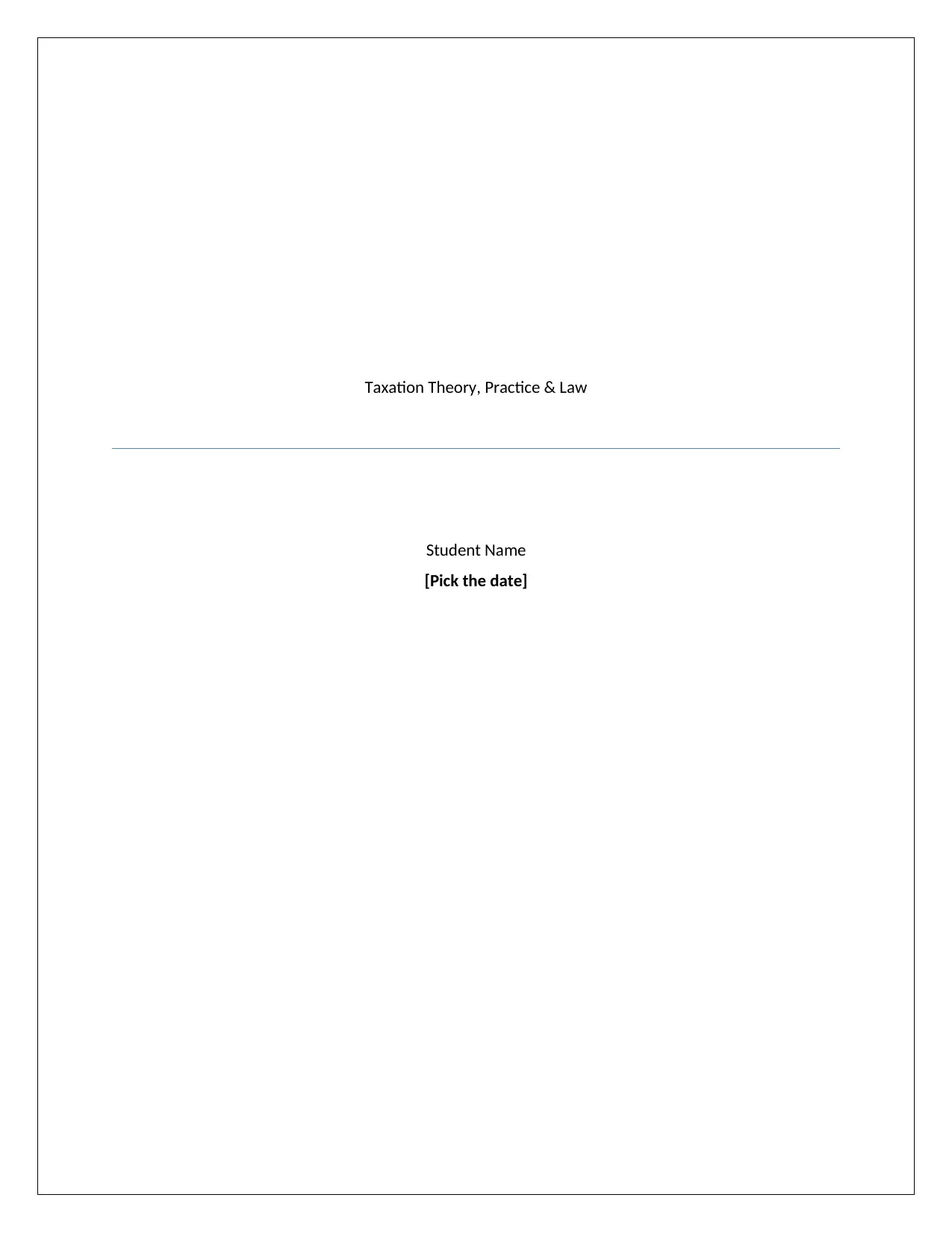
Taxation Theory, Practice & Law
Student Name
[Pick the date]
Student Name
[Pick the date]
Paraphrase This Document
Need a fresh take? Get an instant paraphrase of this document with our AI Paraphraser
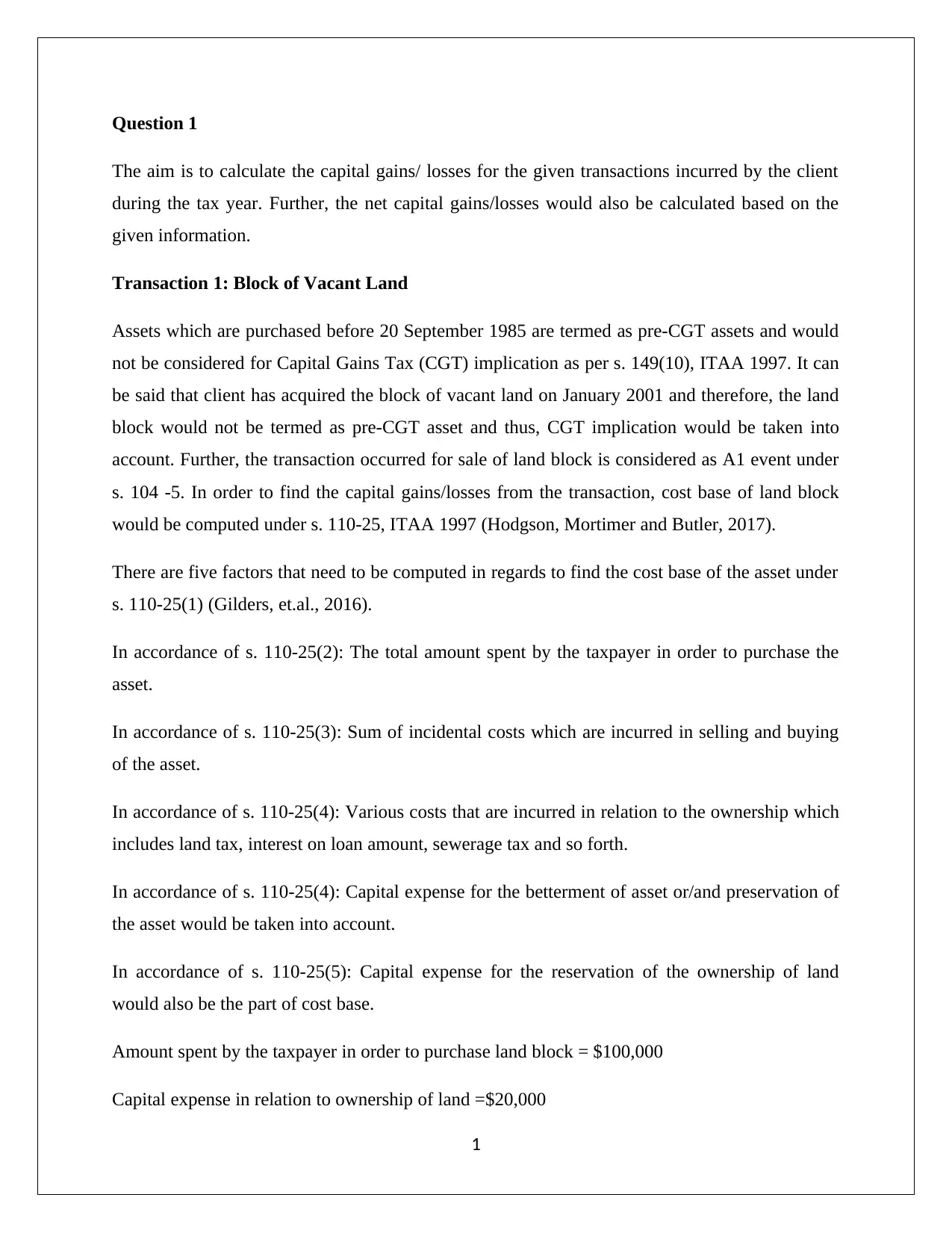
Question 1
The aim is to calculate the capital gains/ losses for the given transactions incurred by the client
during the tax year. Further, the net capital gains/losses would also be calculated based on the
given information.
Transaction 1: Block of Vacant Land
Assets which are purchased before 20 September 1985 are termed as pre-CGT assets and would
not be considered for Capital Gains Tax (CGT) implication as per s. 149(10), ITAA 1997. It can
be said that client has acquired the block of vacant land on January 2001 and therefore, the land
block would not be termed as pre-CGT asset and thus, CGT implication would be taken into
account. Further, the transaction occurred for sale of land block is considered as A1 event under
s. 104 -5. In order to find the capital gains/losses from the transaction, cost base of land block
would be computed under s. 110-25, ITAA 1997 (Hodgson, Mortimer and Butler, 2017).
There are five factors that need to be computed in regards to find the cost base of the asset under
s. 110-25(1) (Gilders, et.al., 2016).
In accordance of s. 110-25(2): The total amount spent by the taxpayer in order to purchase the
asset.
In accordance of s. 110-25(3): Sum of incidental costs which are incurred in selling and buying
of the asset.
In accordance of s. 110-25(4): Various costs that are incurred in relation to the ownership which
includes land tax, interest on loan amount, sewerage tax and so forth.
In accordance of s. 110-25(4): Capital expense for the betterment of asset or/and preservation of
the asset would be taken into account.
In accordance of s. 110-25(5): Capital expense for the reservation of the ownership of land
would also be the part of cost base.
Amount spent by the taxpayer in order to purchase land block = $100,000
Capital expense in relation to ownership of land =$20,000
1
The aim is to calculate the capital gains/ losses for the given transactions incurred by the client
during the tax year. Further, the net capital gains/losses would also be calculated based on the
given information.
Transaction 1: Block of Vacant Land
Assets which are purchased before 20 September 1985 are termed as pre-CGT assets and would
not be considered for Capital Gains Tax (CGT) implication as per s. 149(10), ITAA 1997. It can
be said that client has acquired the block of vacant land on January 2001 and therefore, the land
block would not be termed as pre-CGT asset and thus, CGT implication would be taken into
account. Further, the transaction occurred for sale of land block is considered as A1 event under
s. 104 -5. In order to find the capital gains/losses from the transaction, cost base of land block
would be computed under s. 110-25, ITAA 1997 (Hodgson, Mortimer and Butler, 2017).
There are five factors that need to be computed in regards to find the cost base of the asset under
s. 110-25(1) (Gilders, et.al., 2016).
In accordance of s. 110-25(2): The total amount spent by the taxpayer in order to purchase the
asset.
In accordance of s. 110-25(3): Sum of incidental costs which are incurred in selling and buying
of the asset.
In accordance of s. 110-25(4): Various costs that are incurred in relation to the ownership which
includes land tax, interest on loan amount, sewerage tax and so forth.
In accordance of s. 110-25(4): Capital expense for the betterment of asset or/and preservation of
the asset would be taken into account.
In accordance of s. 110-25(5): Capital expense for the reservation of the ownership of land
would also be the part of cost base.
Amount spent by the taxpayer in order to purchase land block = $100,000
Capital expense in relation to ownership of land =$20,000
1
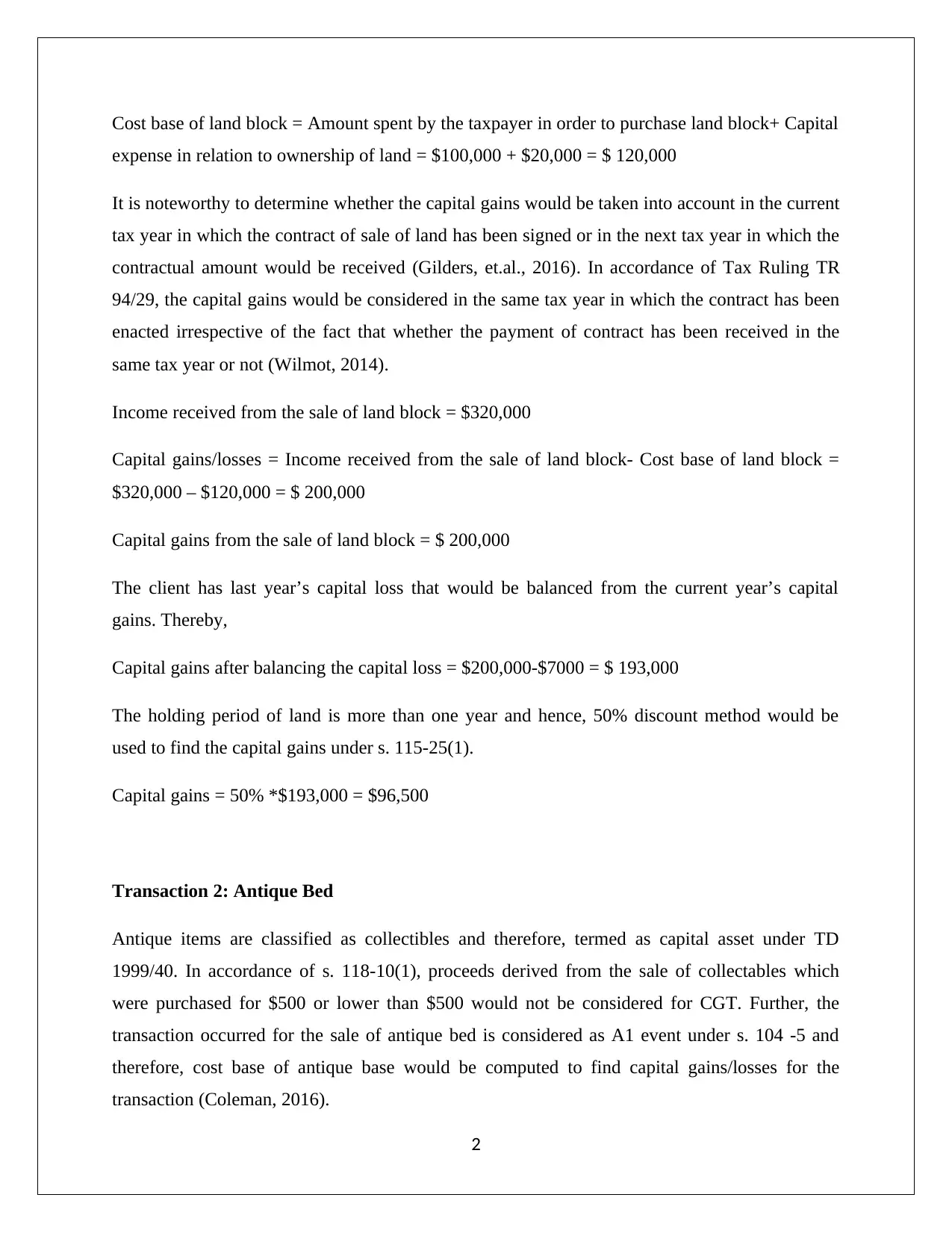
Cost base of land block = Amount spent by the taxpayer in order to purchase land block+ Capital
expense in relation to ownership of land = $100,000 + $20,000 = $ 120,000
It is noteworthy to determine whether the capital gains would be taken into account in the current
tax year in which the contract of sale of land has been signed or in the next tax year in which the
contractual amount would be received (Gilders, et.al., 2016). In accordance of Tax Ruling TR
94/29, the capital gains would be considered in the same tax year in which the contract has been
enacted irrespective of the fact that whether the payment of contract has been received in the
same tax year or not (Wilmot, 2014).
Income received from the sale of land block = $320,000
Capital gains/losses = Income received from the sale of land block- Cost base of land block =
$320,000 – $120,000 = $ 200,000
Capital gains from the sale of land block = $ 200,000
The client has last year’s capital loss that would be balanced from the current year’s capital
gains. Thereby,
Capital gains after balancing the capital loss = $200,000-$7000 = $ 193,000
The holding period of land is more than one year and hence, 50% discount method would be
used to find the capital gains under s. 115-25(1).
Capital gains = 50% *$193,000 = $96,500
Transaction 2: Antique Bed
Antique items are classified as collectibles and therefore, termed as capital asset under TD
1999/40. In accordance of s. 118-10(1), proceeds derived from the sale of collectables which
were purchased for $500 or lower than $500 would not be considered for CGT. Further, the
transaction occurred for the sale of antique bed is considered as A1 event under s. 104 -5 and
therefore, cost base of antique base would be computed to find capital gains/losses for the
transaction (Coleman, 2016).
2
expense in relation to ownership of land = $100,000 + $20,000 = $ 120,000
It is noteworthy to determine whether the capital gains would be taken into account in the current
tax year in which the contract of sale of land has been signed or in the next tax year in which the
contractual amount would be received (Gilders, et.al., 2016). In accordance of Tax Ruling TR
94/29, the capital gains would be considered in the same tax year in which the contract has been
enacted irrespective of the fact that whether the payment of contract has been received in the
same tax year or not (Wilmot, 2014).
Income received from the sale of land block = $320,000
Capital gains/losses = Income received from the sale of land block- Cost base of land block =
$320,000 – $120,000 = $ 200,000
Capital gains from the sale of land block = $ 200,000
The client has last year’s capital loss that would be balanced from the current year’s capital
gains. Thereby,
Capital gains after balancing the capital loss = $200,000-$7000 = $ 193,000
The holding period of land is more than one year and hence, 50% discount method would be
used to find the capital gains under s. 115-25(1).
Capital gains = 50% *$193,000 = $96,500
Transaction 2: Antique Bed
Antique items are classified as collectibles and therefore, termed as capital asset under TD
1999/40. In accordance of s. 118-10(1), proceeds derived from the sale of collectables which
were purchased for $500 or lower than $500 would not be considered for CGT. Further, the
transaction occurred for the sale of antique bed is considered as A1 event under s. 104 -5 and
therefore, cost base of antique base would be computed to find capital gains/losses for the
transaction (Coleman, 2016).
2
⊘ This is a preview!⊘
Do you want full access?
Subscribe today to unlock all pages.

Trusted by 1+ million students worldwide
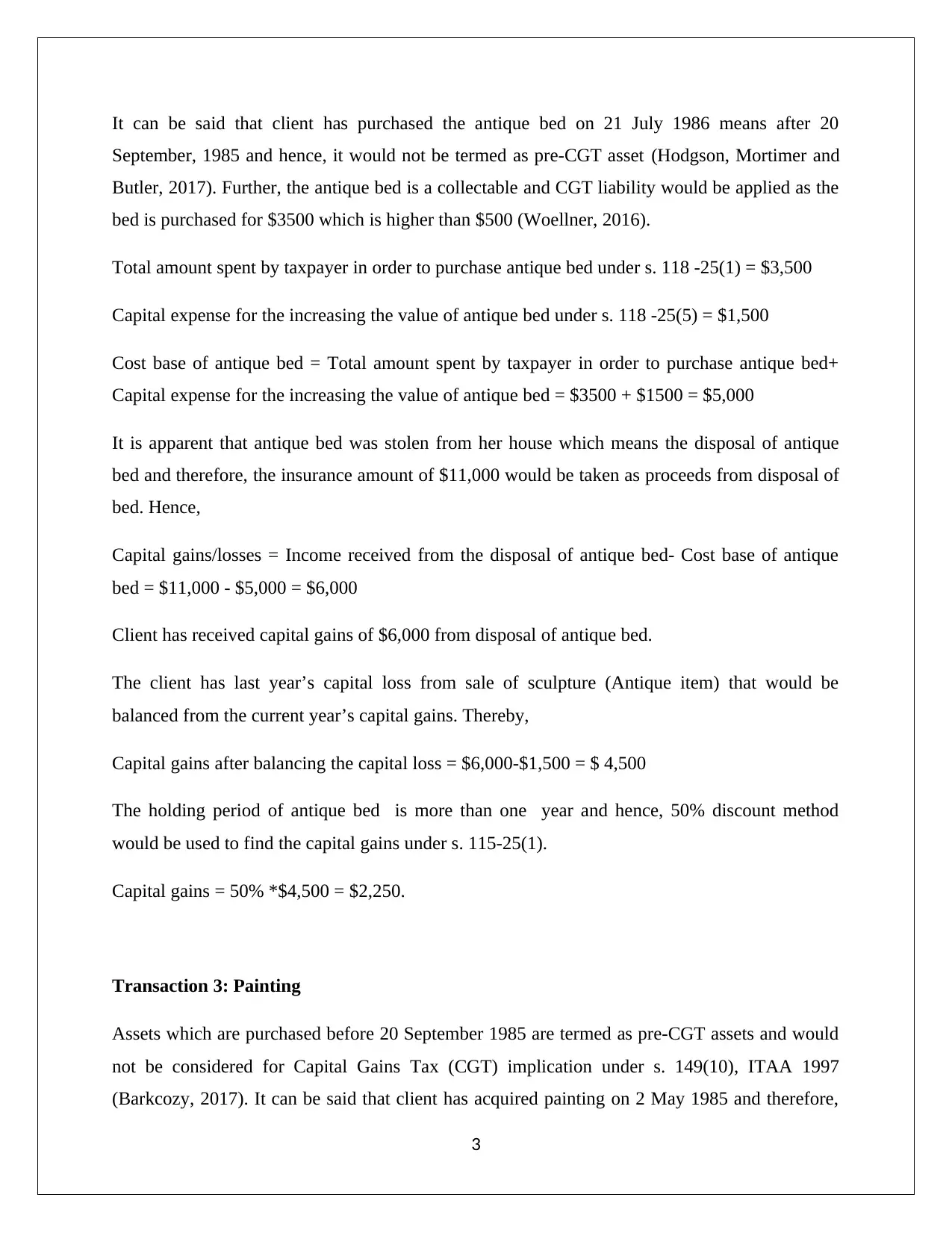
It can be said that client has purchased the antique bed on 21 July 1986 means after 20
September, 1985 and hence, it would not be termed as pre-CGT asset (Hodgson, Mortimer and
Butler, 2017). Further, the antique bed is a collectable and CGT liability would be applied as the
bed is purchased for $3500 which is higher than $500 (Woellner, 2016).
Total amount spent by taxpayer in order to purchase antique bed under s. 118 -25(1) = $3,500
Capital expense for the increasing the value of antique bed under s. 118 -25(5) = $1,500
Cost base of antique bed = Total amount spent by taxpayer in order to purchase antique bed+
Capital expense for the increasing the value of antique bed = $3500 + $1500 = $5,000
It is apparent that antique bed was stolen from her house which means the disposal of antique
bed and therefore, the insurance amount of $11,000 would be taken as proceeds from disposal of
bed. Hence,
Capital gains/losses = Income received from the disposal of antique bed- Cost base of antique
bed = $11,000 - $5,000 = $6,000
Client has received capital gains of $6,000 from disposal of antique bed.
The client has last year’s capital loss from sale of sculpture (Antique item) that would be
balanced from the current year’s capital gains. Thereby,
Capital gains after balancing the capital loss = $6,000-$1,500 = $ 4,500
The holding period of antique bed is more than one year and hence, 50% discount method
would be used to find the capital gains under s. 115-25(1).
Capital gains = 50% *$4,500 = $2,250.
Transaction 3: Painting
Assets which are purchased before 20 September 1985 are termed as pre-CGT assets and would
not be considered for Capital Gains Tax (CGT) implication under s. 149(10), ITAA 1997
(Barkcozy, 2017). It can be said that client has acquired painting on 2 May 1985 and therefore,
3
September, 1985 and hence, it would not be termed as pre-CGT asset (Hodgson, Mortimer and
Butler, 2017). Further, the antique bed is a collectable and CGT liability would be applied as the
bed is purchased for $3500 which is higher than $500 (Woellner, 2016).
Total amount spent by taxpayer in order to purchase antique bed under s. 118 -25(1) = $3,500
Capital expense for the increasing the value of antique bed under s. 118 -25(5) = $1,500
Cost base of antique bed = Total amount spent by taxpayer in order to purchase antique bed+
Capital expense for the increasing the value of antique bed = $3500 + $1500 = $5,000
It is apparent that antique bed was stolen from her house which means the disposal of antique
bed and therefore, the insurance amount of $11,000 would be taken as proceeds from disposal of
bed. Hence,
Capital gains/losses = Income received from the disposal of antique bed- Cost base of antique
bed = $11,000 - $5,000 = $6,000
Client has received capital gains of $6,000 from disposal of antique bed.
The client has last year’s capital loss from sale of sculpture (Antique item) that would be
balanced from the current year’s capital gains. Thereby,
Capital gains after balancing the capital loss = $6,000-$1,500 = $ 4,500
The holding period of antique bed is more than one year and hence, 50% discount method
would be used to find the capital gains under s. 115-25(1).
Capital gains = 50% *$4,500 = $2,250.
Transaction 3: Painting
Assets which are purchased before 20 September 1985 are termed as pre-CGT assets and would
not be considered for Capital Gains Tax (CGT) implication under s. 149(10), ITAA 1997
(Barkcozy, 2017). It can be said that client has acquired painting on 2 May 1985 and therefore,
3
Paraphrase This Document
Need a fresh take? Get an instant paraphrase of this document with our AI Paraphraser
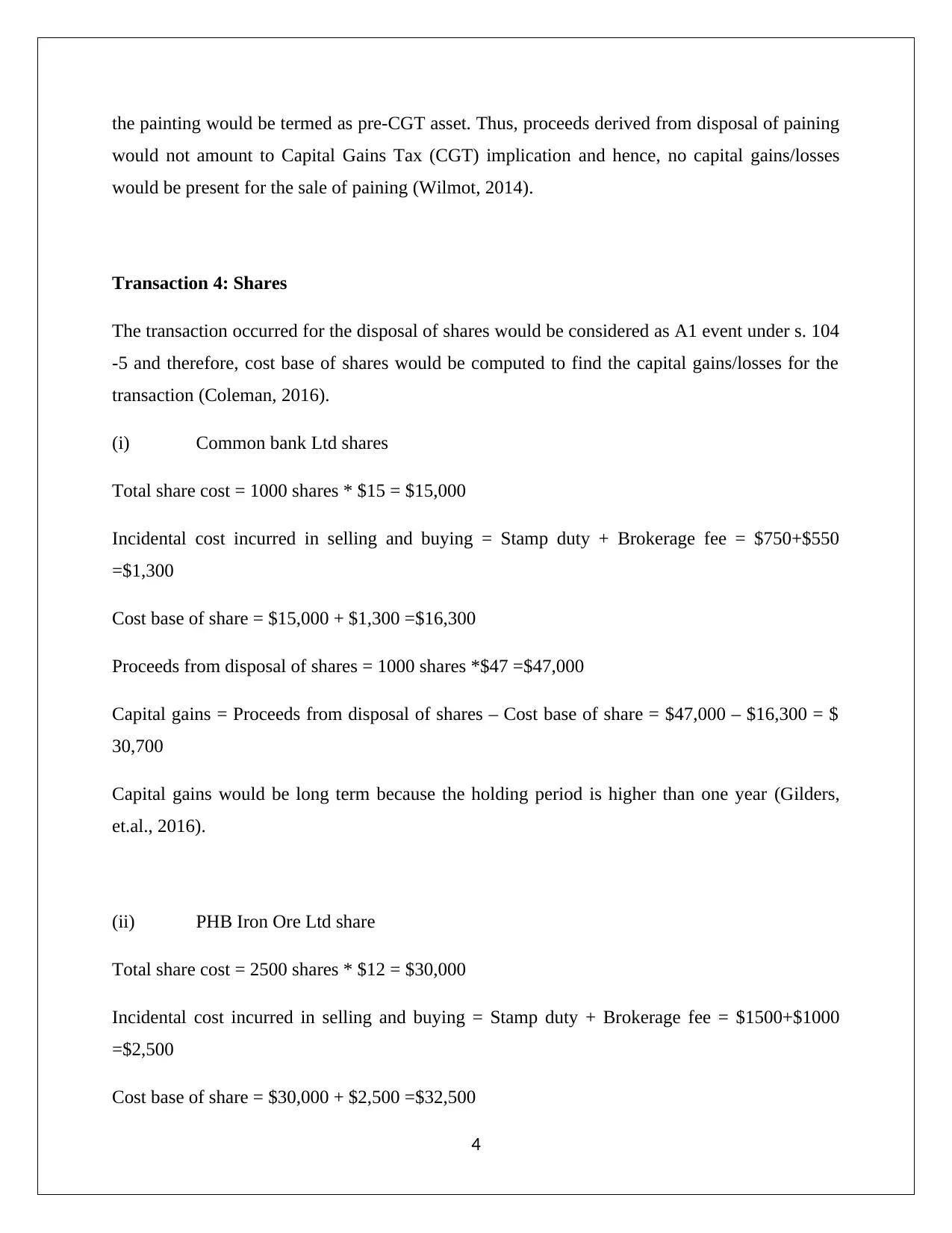
the painting would be termed as pre-CGT asset. Thus, proceeds derived from disposal of paining
would not amount to Capital Gains Tax (CGT) implication and hence, no capital gains/losses
would be present for the sale of paining (Wilmot, 2014).
Transaction 4: Shares
The transaction occurred for the disposal of shares would be considered as A1 event under s. 104
-5 and therefore, cost base of shares would be computed to find the capital gains/losses for the
transaction (Coleman, 2016).
(i) Common bank Ltd shares
Total share cost = 1000 shares * $15 = $15,000
Incidental cost incurred in selling and buying = Stamp duty + Brokerage fee = $750+$550
=$1,300
Cost base of share = $15,000 + $1,300 =$16,300
Proceeds from disposal of shares = 1000 shares *$47 =$47,000
Capital gains = Proceeds from disposal of shares – Cost base of share = $47,000 – $16,300 = $
30,700
Capital gains would be long term because the holding period is higher than one year (Gilders,
et.al., 2016).
(ii) PHB Iron Ore Ltd share
Total share cost = 2500 shares * $12 = $30,000
Incidental cost incurred in selling and buying = Stamp duty + Brokerage fee = $1500+$1000
=$2,500
Cost base of share = $30,000 + $2,500 =$32,500
4
would not amount to Capital Gains Tax (CGT) implication and hence, no capital gains/losses
would be present for the sale of paining (Wilmot, 2014).
Transaction 4: Shares
The transaction occurred for the disposal of shares would be considered as A1 event under s. 104
-5 and therefore, cost base of shares would be computed to find the capital gains/losses for the
transaction (Coleman, 2016).
(i) Common bank Ltd shares
Total share cost = 1000 shares * $15 = $15,000
Incidental cost incurred in selling and buying = Stamp duty + Brokerage fee = $750+$550
=$1,300
Cost base of share = $15,000 + $1,300 =$16,300
Proceeds from disposal of shares = 1000 shares *$47 =$47,000
Capital gains = Proceeds from disposal of shares – Cost base of share = $47,000 – $16,300 = $
30,700
Capital gains would be long term because the holding period is higher than one year (Gilders,
et.al., 2016).
(ii) PHB Iron Ore Ltd share
Total share cost = 2500 shares * $12 = $30,000
Incidental cost incurred in selling and buying = Stamp duty + Brokerage fee = $1500+$1000
=$2,500
Cost base of share = $30,000 + $2,500 =$32,500
4
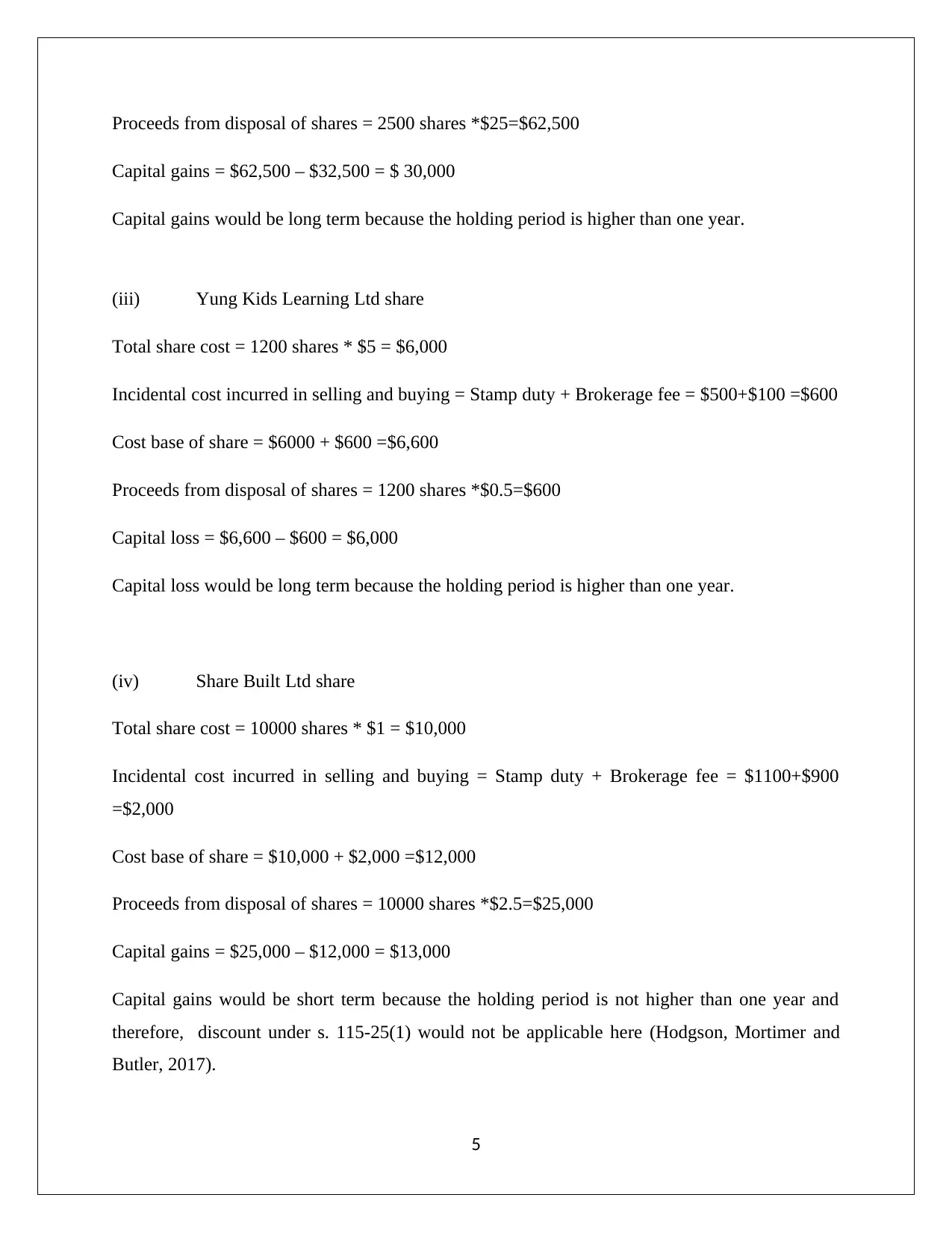
Proceeds from disposal of shares = 2500 shares *$25=$62,500
Capital gains = $62,500 – $32,500 = $ 30,000
Capital gains would be long term because the holding period is higher than one year.
(iii) Yung Kids Learning Ltd share
Total share cost = 1200 shares * $5 = $6,000
Incidental cost incurred in selling and buying = Stamp duty + Brokerage fee = $500+$100 =$600
Cost base of share = $6000 + $600 =$6,600
Proceeds from disposal of shares = 1200 shares *$0.5=$600
Capital loss = $6,600 – $600 = $6,000
Capital loss would be long term because the holding period is higher than one year.
(iv) Share Built Ltd share
Total share cost = 10000 shares * $1 = $10,000
Incidental cost incurred in selling and buying = Stamp duty + Brokerage fee = $1100+$900
=$2,000
Cost base of share = $10,000 + $2,000 =$12,000
Proceeds from disposal of shares = 10000 shares *$2.5=$25,000
Capital gains = $25,000 – $12,000 = $13,000
Capital gains would be short term because the holding period is not higher than one year and
therefore, discount under s. 115-25(1) would not be applicable here (Hodgson, Mortimer and
Butler, 2017).
5
Capital gains = $62,500 – $32,500 = $ 30,000
Capital gains would be long term because the holding period is higher than one year.
(iii) Yung Kids Learning Ltd share
Total share cost = 1200 shares * $5 = $6,000
Incidental cost incurred in selling and buying = Stamp duty + Brokerage fee = $500+$100 =$600
Cost base of share = $6000 + $600 =$6,600
Proceeds from disposal of shares = 1200 shares *$0.5=$600
Capital loss = $6,600 – $600 = $6,000
Capital loss would be long term because the holding period is higher than one year.
(iv) Share Built Ltd share
Total share cost = 10000 shares * $1 = $10,000
Incidental cost incurred in selling and buying = Stamp duty + Brokerage fee = $1100+$900
=$2,000
Cost base of share = $10,000 + $2,000 =$12,000
Proceeds from disposal of shares = 10000 shares *$2.5=$25,000
Capital gains = $25,000 – $12,000 = $13,000
Capital gains would be short term because the holding period is not higher than one year and
therefore, discount under s. 115-25(1) would not be applicable here (Hodgson, Mortimer and
Butler, 2017).
5
⊘ This is a preview!⊘
Do you want full access?
Subscribe today to unlock all pages.

Trusted by 1+ million students worldwide
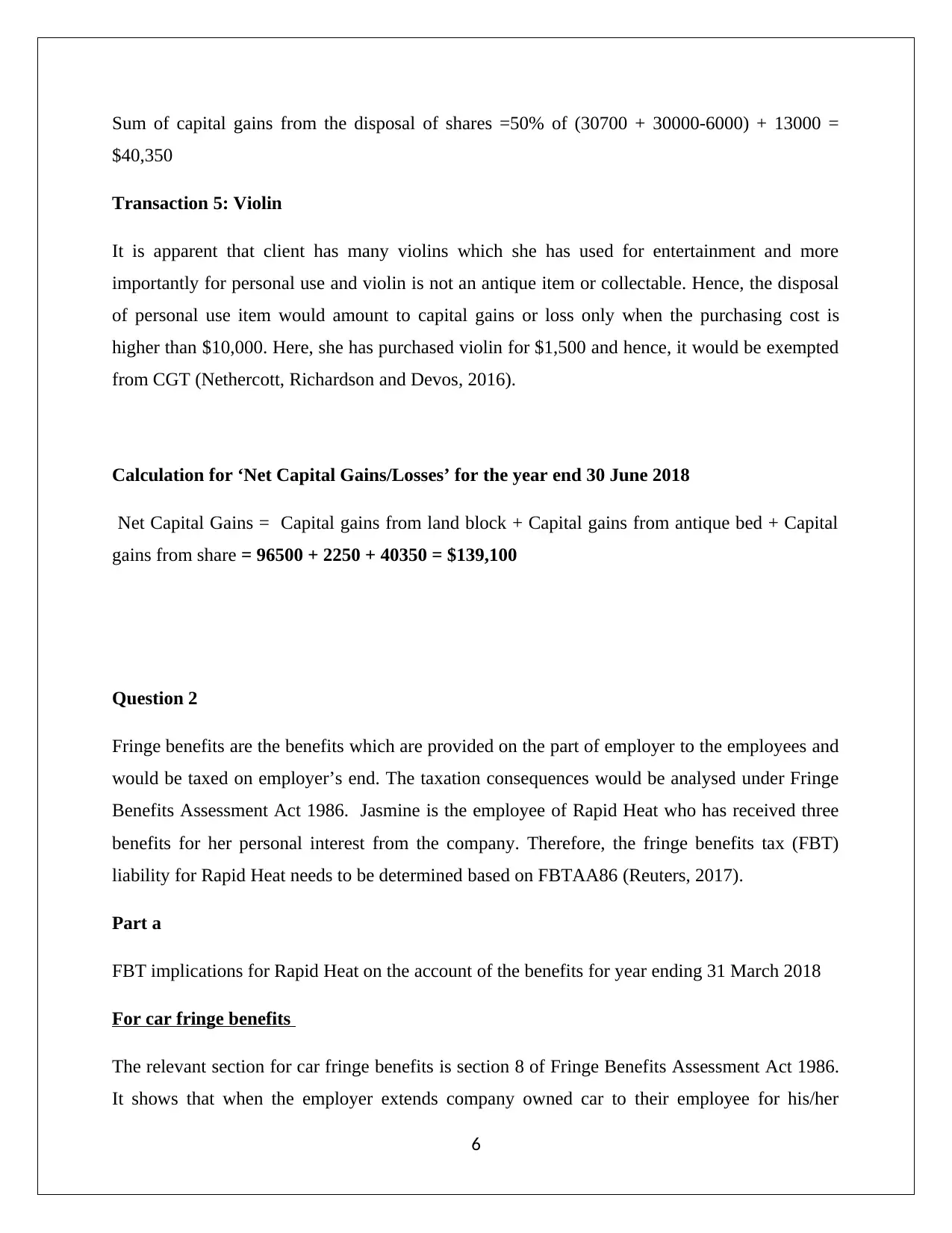
Sum of capital gains from the disposal of shares =50% of (30700 + 30000-6000) + 13000 =
$40,350
Transaction 5: Violin
It is apparent that client has many violins which she has used for entertainment and more
importantly for personal use and violin is not an antique item or collectable. Hence, the disposal
of personal use item would amount to capital gains or loss only when the purchasing cost is
higher than $10,000. Here, she has purchased violin for $1,500 and hence, it would be exempted
from CGT (Nethercott, Richardson and Devos, 2016).
Calculation for ‘Net Capital Gains/Losses’ for the year end 30 June 2018
Net Capital Gains = Capital gains from land block + Capital gains from antique bed + Capital
gains from share = 96500 + 2250 + 40350 = $139,100
Question 2
Fringe benefits are the benefits which are provided on the part of employer to the employees and
would be taxed on employer’s end. The taxation consequences would be analysed under Fringe
Benefits Assessment Act 1986. Jasmine is the employee of Rapid Heat who has received three
benefits for her personal interest from the company. Therefore, the fringe benefits tax (FBT)
liability for Rapid Heat needs to be determined based on FBTAA86 (Reuters, 2017).
Part a
FBT implications for Rapid Heat on the account of the benefits for year ending 31 March 2018
For car fringe benefits
The relevant section for car fringe benefits is section 8 of Fringe Benefits Assessment Act 1986.
It shows that when the employer extends company owned car to their employee for his/her
6
$40,350
Transaction 5: Violin
It is apparent that client has many violins which she has used for entertainment and more
importantly for personal use and violin is not an antique item or collectable. Hence, the disposal
of personal use item would amount to capital gains or loss only when the purchasing cost is
higher than $10,000. Here, she has purchased violin for $1,500 and hence, it would be exempted
from CGT (Nethercott, Richardson and Devos, 2016).
Calculation for ‘Net Capital Gains/Losses’ for the year end 30 June 2018
Net Capital Gains = Capital gains from land block + Capital gains from antique bed + Capital
gains from share = 96500 + 2250 + 40350 = $139,100
Question 2
Fringe benefits are the benefits which are provided on the part of employer to the employees and
would be taxed on employer’s end. The taxation consequences would be analysed under Fringe
Benefits Assessment Act 1986. Jasmine is the employee of Rapid Heat who has received three
benefits for her personal interest from the company. Therefore, the fringe benefits tax (FBT)
liability for Rapid Heat needs to be determined based on FBTAA86 (Reuters, 2017).
Part a
FBT implications for Rapid Heat on the account of the benefits for year ending 31 March 2018
For car fringe benefits
The relevant section for car fringe benefits is section 8 of Fringe Benefits Assessment Act 1986.
It shows that when the employer extends company owned car to their employee for his/her
6
Paraphrase This Document
Need a fresh take? Get an instant paraphrase of this document with our AI Paraphraser
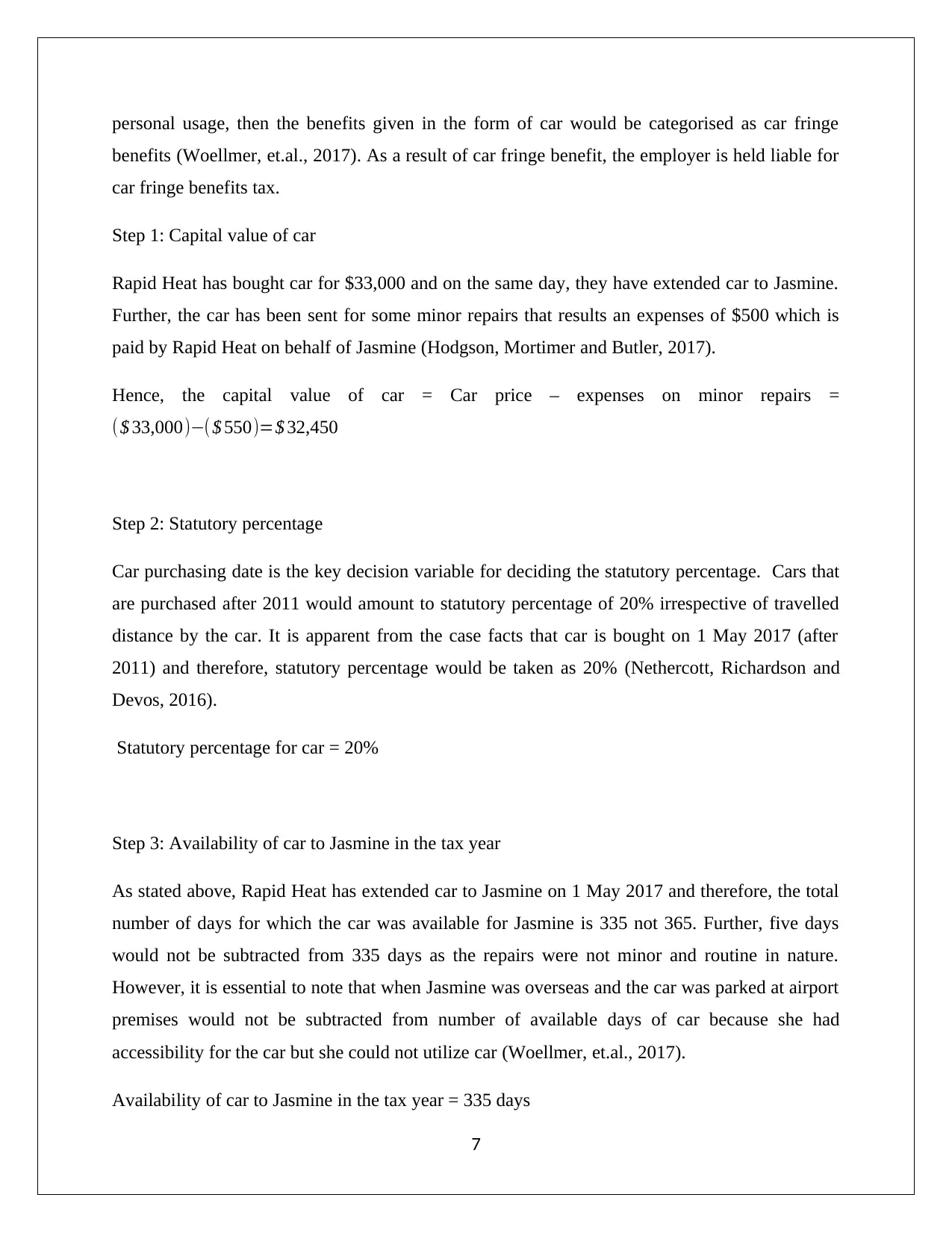
personal usage, then the benefits given in the form of car would be categorised as car fringe
benefits (Woellmer, et.al., 2017). As a result of car fringe benefit, the employer is held liable for
car fringe benefits tax.
Step 1: Capital value of car
Rapid Heat has bought car for $33,000 and on the same day, they have extended car to Jasmine.
Further, the car has been sent for some minor repairs that results an expenses of $500 which is
paid by Rapid Heat on behalf of Jasmine (Hodgson, Mortimer and Butler, 2017).
Hence, the capital value of car = Car price – expenses on minor repairs =
($ 33,000)−( $ 550)=$ 32,450
Step 2: Statutory percentage
Car purchasing date is the key decision variable for deciding the statutory percentage. Cars that
are purchased after 2011 would amount to statutory percentage of 20% irrespective of travelled
distance by the car. It is apparent from the case facts that car is bought on 1 May 2017 (after
2011) and therefore, statutory percentage would be taken as 20% (Nethercott, Richardson and
Devos, 2016).
Statutory percentage for car = 20%
Step 3: Availability of car to Jasmine in the tax year
As stated above, Rapid Heat has extended car to Jasmine on 1 May 2017 and therefore, the total
number of days for which the car was available for Jasmine is 335 not 365. Further, five days
would not be subtracted from 335 days as the repairs were not minor and routine in nature.
However, it is essential to note that when Jasmine was overseas and the car was parked at airport
premises would not be subtracted from number of available days of car because she had
accessibility for the car but she could not utilize car (Woellmer, et.al., 2017).
Availability of car to Jasmine in the tax year = 335 days
7
benefits (Woellmer, et.al., 2017). As a result of car fringe benefit, the employer is held liable for
car fringe benefits tax.
Step 1: Capital value of car
Rapid Heat has bought car for $33,000 and on the same day, they have extended car to Jasmine.
Further, the car has been sent for some minor repairs that results an expenses of $500 which is
paid by Rapid Heat on behalf of Jasmine (Hodgson, Mortimer and Butler, 2017).
Hence, the capital value of car = Car price – expenses on minor repairs =
($ 33,000)−( $ 550)=$ 32,450
Step 2: Statutory percentage
Car purchasing date is the key decision variable for deciding the statutory percentage. Cars that
are purchased after 2011 would amount to statutory percentage of 20% irrespective of travelled
distance by the car. It is apparent from the case facts that car is bought on 1 May 2017 (after
2011) and therefore, statutory percentage would be taken as 20% (Nethercott, Richardson and
Devos, 2016).
Statutory percentage for car = 20%
Step 3: Availability of car to Jasmine in the tax year
As stated above, Rapid Heat has extended car to Jasmine on 1 May 2017 and therefore, the total
number of days for which the car was available for Jasmine is 335 not 365. Further, five days
would not be subtracted from 335 days as the repairs were not minor and routine in nature.
However, it is essential to note that when Jasmine was overseas and the car was parked at airport
premises would not be subtracted from number of available days of car because she had
accessibility for the car but she could not utilize car (Woellmer, et.al., 2017).
Availability of car to Jasmine in the tax year = 335 days
7
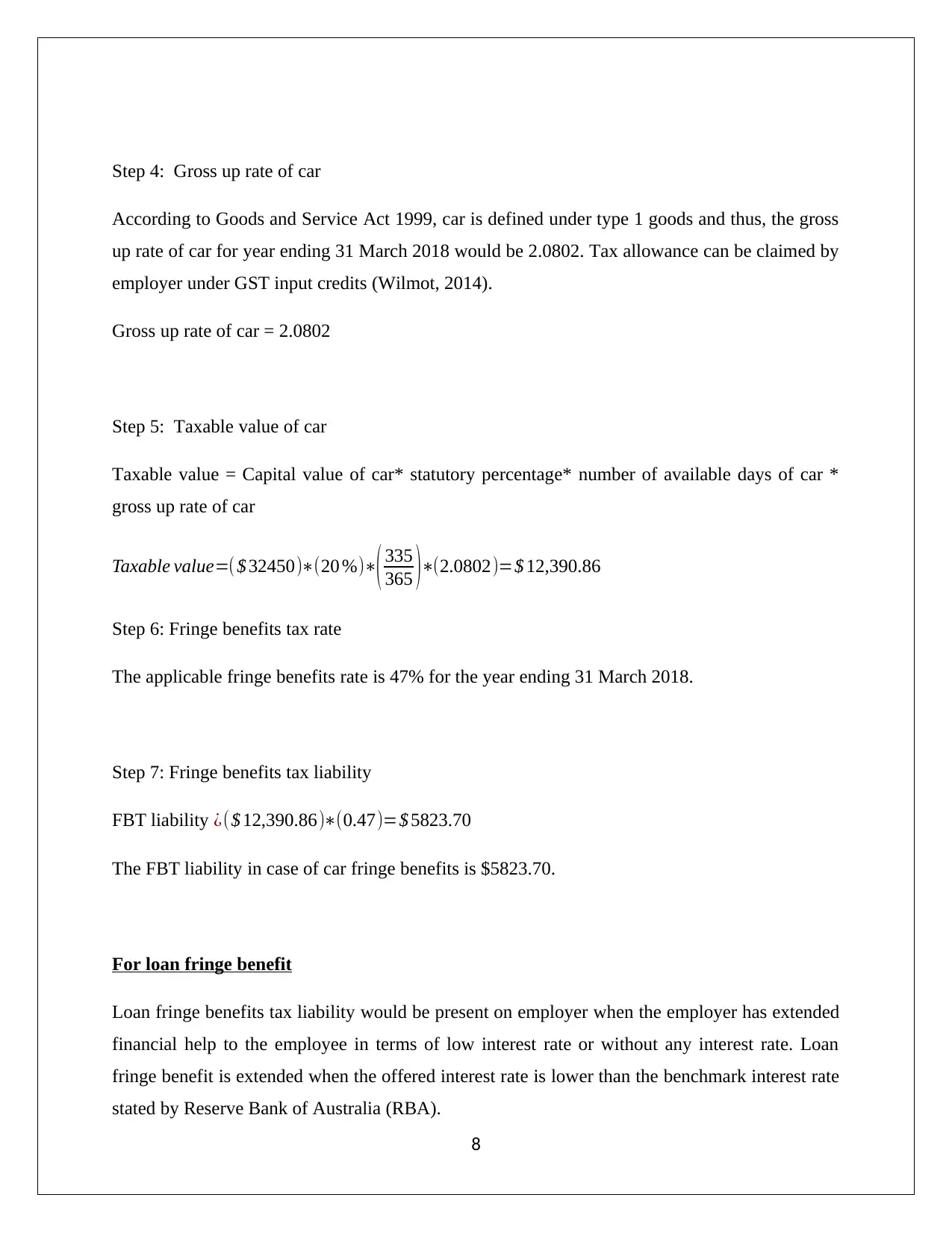
Step 4: Gross up rate of car
According to Goods and Service Act 1999, car is defined under type 1 goods and thus, the gross
up rate of car for year ending 31 March 2018 would be 2.0802. Tax allowance can be claimed by
employer under GST input credits (Wilmot, 2014).
Gross up rate of car = 2.0802
Step 5: Taxable value of car
Taxable value = Capital value of car* statutory percentage* number of available days of car *
gross up rate of car
Taxable value=( $ 32450)∗(20 %)∗( 335
365 )∗(2.0802)=$ 12,390.86
Step 6: Fringe benefits tax rate
The applicable fringe benefits rate is 47% for the year ending 31 March 2018.
Step 7: Fringe benefits tax liability
FBT liability ¿($ 12,390.86)∗(0.47)=$ 5823.70
The FBT liability in case of car fringe benefits is $5823.70.
For loan fringe benefit
Loan fringe benefits tax liability would be present on employer when the employer has extended
financial help to the employee in terms of low interest rate or without any interest rate. Loan
fringe benefit is extended when the offered interest rate is lower than the benchmark interest rate
stated by Reserve Bank of Australia (RBA).
8
According to Goods and Service Act 1999, car is defined under type 1 goods and thus, the gross
up rate of car for year ending 31 March 2018 would be 2.0802. Tax allowance can be claimed by
employer under GST input credits (Wilmot, 2014).
Gross up rate of car = 2.0802
Step 5: Taxable value of car
Taxable value = Capital value of car* statutory percentage* number of available days of car *
gross up rate of car
Taxable value=( $ 32450)∗(20 %)∗( 335
365 )∗(2.0802)=$ 12,390.86
Step 6: Fringe benefits tax rate
The applicable fringe benefits rate is 47% for the year ending 31 March 2018.
Step 7: Fringe benefits tax liability
FBT liability ¿($ 12,390.86)∗(0.47)=$ 5823.70
The FBT liability in case of car fringe benefits is $5823.70.
For loan fringe benefit
Loan fringe benefits tax liability would be present on employer when the employer has extended
financial help to the employee in terms of low interest rate or without any interest rate. Loan
fringe benefit is extended when the offered interest rate is lower than the benchmark interest rate
stated by Reserve Bank of Australia (RBA).
8
⊘ This is a preview!⊘
Do you want full access?
Subscribe today to unlock all pages.

Trusted by 1+ million students worldwide
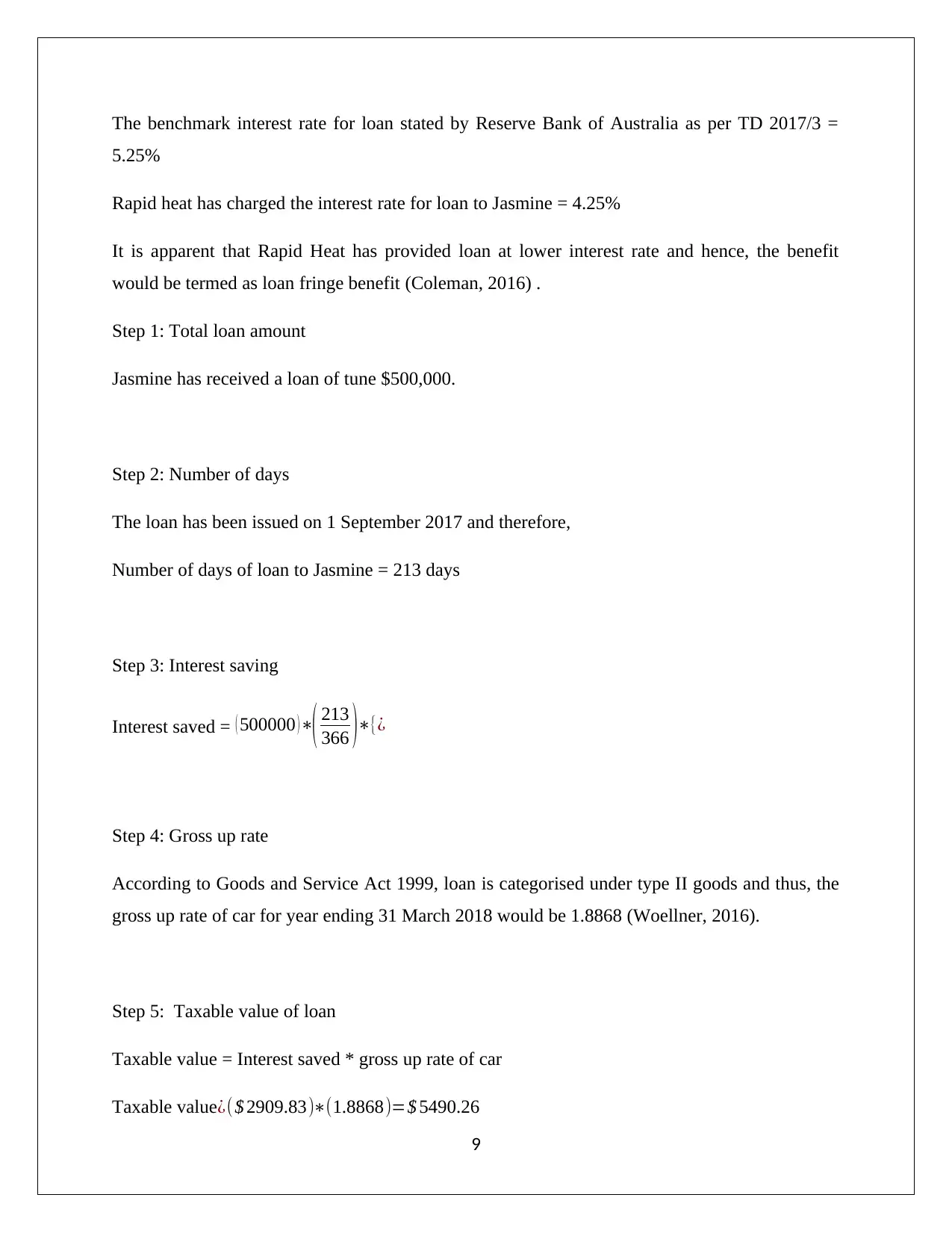
The benchmark interest rate for loan stated by Reserve Bank of Australia as per TD 2017/3 =
5.25%
Rapid heat has charged the interest rate for loan to Jasmine = 4.25%
It is apparent that Rapid Heat has provided loan at lower interest rate and hence, the benefit
would be termed as loan fringe benefit (Coleman, 2016) .
Step 1: Total loan amount
Jasmine has received a loan of tune $500,000.
Step 2: Number of days
The loan has been issued on 1 September 2017 and therefore,
Number of days of loan to Jasmine = 213 days
Step 3: Interest saving
Interest saved = ( 500000 )∗( 213
366 )∗{¿
Step 4: Gross up rate
According to Goods and Service Act 1999, loan is categorised under type II goods and thus, the
gross up rate of car for year ending 31 March 2018 would be 1.8868 (Woellner, 2016).
Step 5: Taxable value of loan
Taxable value = Interest saved * gross up rate of car
Taxable value¿($ 2909.83)∗(1.8868)=$ 5490.26
9
5.25%
Rapid heat has charged the interest rate for loan to Jasmine = 4.25%
It is apparent that Rapid Heat has provided loan at lower interest rate and hence, the benefit
would be termed as loan fringe benefit (Coleman, 2016) .
Step 1: Total loan amount
Jasmine has received a loan of tune $500,000.
Step 2: Number of days
The loan has been issued on 1 September 2017 and therefore,
Number of days of loan to Jasmine = 213 days
Step 3: Interest saving
Interest saved = ( 500000 )∗( 213
366 )∗{¿
Step 4: Gross up rate
According to Goods and Service Act 1999, loan is categorised under type II goods and thus, the
gross up rate of car for year ending 31 March 2018 would be 1.8868 (Woellner, 2016).
Step 5: Taxable value of loan
Taxable value = Interest saved * gross up rate of car
Taxable value¿($ 2909.83)∗(1.8868)=$ 5490.26
9
Paraphrase This Document
Need a fresh take? Get an instant paraphrase of this document with our AI Paraphraser
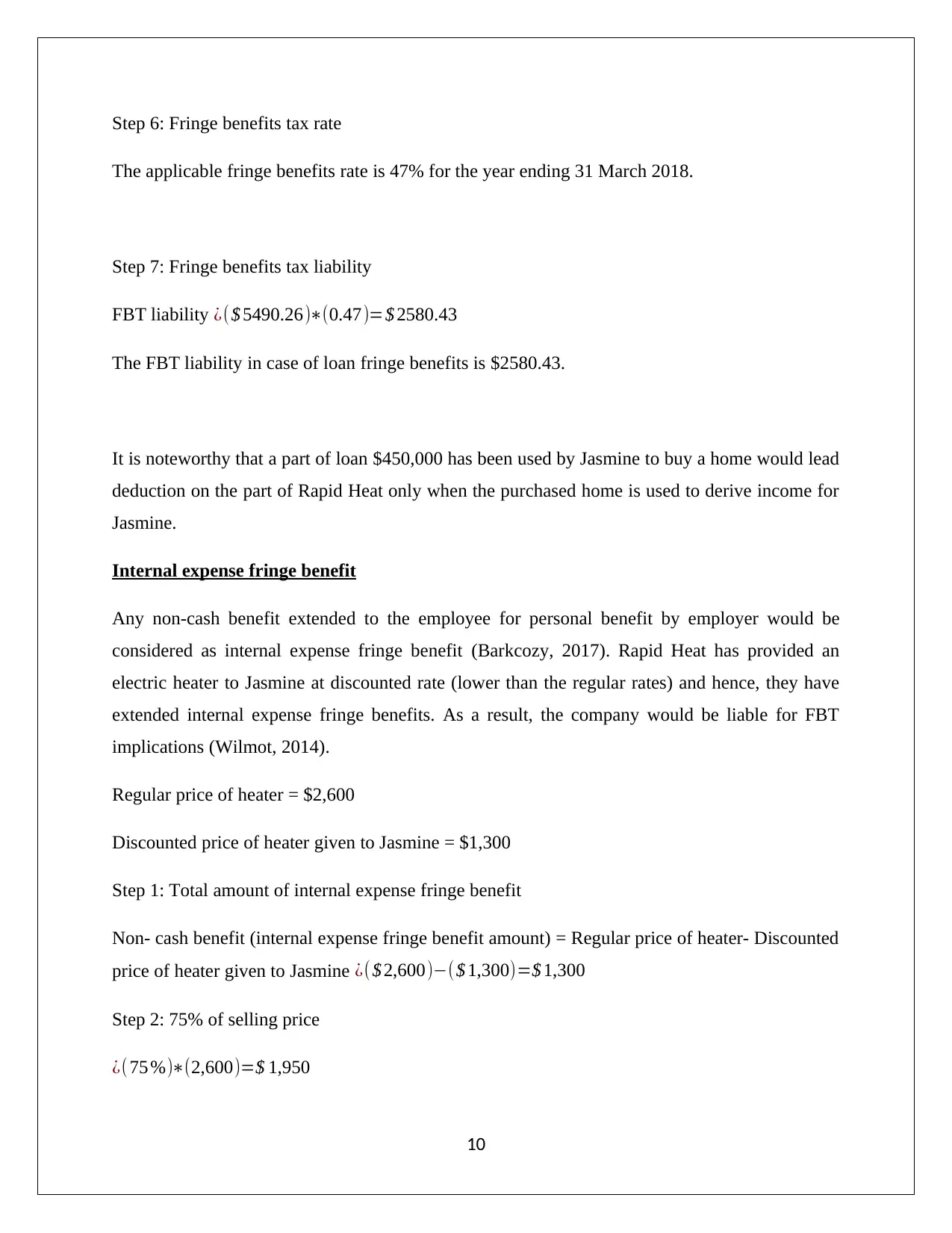
Step 6: Fringe benefits tax rate
The applicable fringe benefits rate is 47% for the year ending 31 March 2018.
Step 7: Fringe benefits tax liability
FBT liability ¿($ 5490.26)∗(0.47)=$ 2580.43
The FBT liability in case of loan fringe benefits is $2580.43.
It is noteworthy that a part of loan $450,000 has been used by Jasmine to buy a home would lead
deduction on the part of Rapid Heat only when the purchased home is used to derive income for
Jasmine.
Internal expense fringe benefit
Any non-cash benefit extended to the employee for personal benefit by employer would be
considered as internal expense fringe benefit (Barkcozy, 2017). Rapid Heat has provided an
electric heater to Jasmine at discounted rate (lower than the regular rates) and hence, they have
extended internal expense fringe benefits. As a result, the company would be liable for FBT
implications (Wilmot, 2014).
Regular price of heater = $2,600
Discounted price of heater given to Jasmine = $1,300
Step 1: Total amount of internal expense fringe benefit
Non- cash benefit (internal expense fringe benefit amount) = Regular price of heater- Discounted
price of heater given to Jasmine ¿( $ 2,600)−($ 1,300)=$ 1,300
Step 2: 75% of selling price
¿( 75 %)∗(2,600)=$ 1,950
10
The applicable fringe benefits rate is 47% for the year ending 31 March 2018.
Step 7: Fringe benefits tax liability
FBT liability ¿($ 5490.26)∗(0.47)=$ 2580.43
The FBT liability in case of loan fringe benefits is $2580.43.
It is noteworthy that a part of loan $450,000 has been used by Jasmine to buy a home would lead
deduction on the part of Rapid Heat only when the purchased home is used to derive income for
Jasmine.
Internal expense fringe benefit
Any non-cash benefit extended to the employee for personal benefit by employer would be
considered as internal expense fringe benefit (Barkcozy, 2017). Rapid Heat has provided an
electric heater to Jasmine at discounted rate (lower than the regular rates) and hence, they have
extended internal expense fringe benefits. As a result, the company would be liable for FBT
implications (Wilmot, 2014).
Regular price of heater = $2,600
Discounted price of heater given to Jasmine = $1,300
Step 1: Total amount of internal expense fringe benefit
Non- cash benefit (internal expense fringe benefit amount) = Regular price of heater- Discounted
price of heater given to Jasmine ¿( $ 2,600)−($ 1,300)=$ 1,300
Step 2: 75% of selling price
¿( 75 %)∗(2,600)=$ 1,950
10
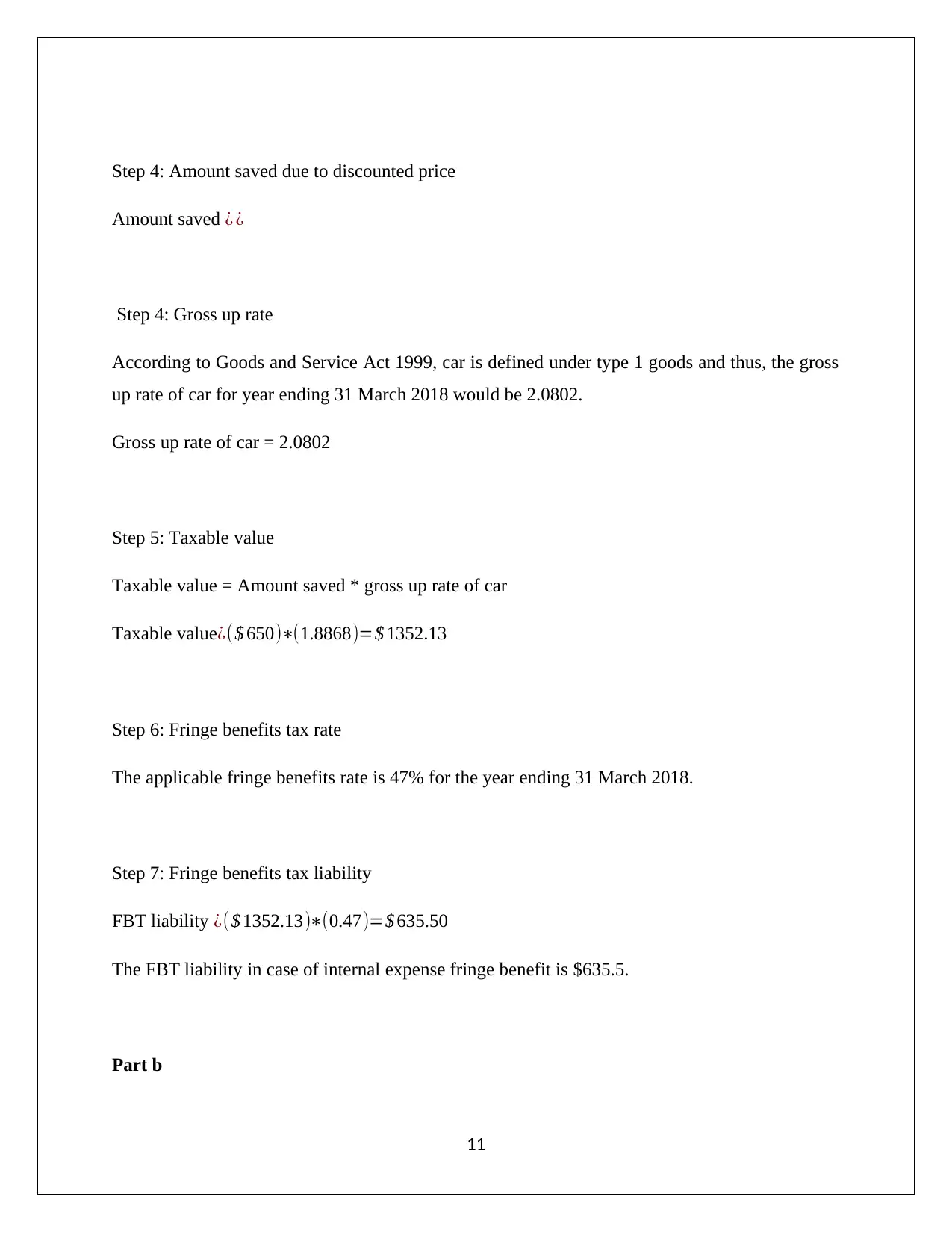
Step 4: Amount saved due to discounted price
Amount saved ¿ ¿
Step 4: Gross up rate
According to Goods and Service Act 1999, car is defined under type 1 goods and thus, the gross
up rate of car for year ending 31 March 2018 would be 2.0802.
Gross up rate of car = 2.0802
Step 5: Taxable value
Taxable value = Amount saved * gross up rate of car
Taxable value¿($ 650)∗(1.8868)=$ 1352.13
Step 6: Fringe benefits tax rate
The applicable fringe benefits rate is 47% for the year ending 31 March 2018.
Step 7: Fringe benefits tax liability
FBT liability ¿($ 1352.13)∗(0.47)=$ 635.50
The FBT liability in case of internal expense fringe benefit is $635.5.
Part b
11
Amount saved ¿ ¿
Step 4: Gross up rate
According to Goods and Service Act 1999, car is defined under type 1 goods and thus, the gross
up rate of car for year ending 31 March 2018 would be 2.0802.
Gross up rate of car = 2.0802
Step 5: Taxable value
Taxable value = Amount saved * gross up rate of car
Taxable value¿($ 650)∗(1.8868)=$ 1352.13
Step 6: Fringe benefits tax rate
The applicable fringe benefits rate is 47% for the year ending 31 March 2018.
Step 7: Fringe benefits tax liability
FBT liability ¿($ 1352.13)∗(0.47)=$ 635.50
The FBT liability in case of internal expense fringe benefit is $635.5.
Part b
11
⊘ This is a preview!⊘
Do you want full access?
Subscribe today to unlock all pages.

Trusted by 1+ million students worldwide
1 out of 15
Related Documents
Your All-in-One AI-Powered Toolkit for Academic Success.
+13062052269
info@desklib.com
Available 24*7 on WhatsApp / Email
![[object Object]](/_next/static/media/star-bottom.7253800d.svg)
Unlock your academic potential
Copyright © 2020–2025 A2Z Services. All Rights Reserved. Developed and managed by ZUCOL.


